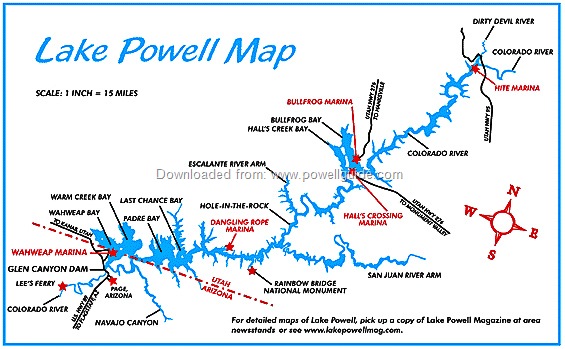13 March 1984
The Navajo knew Rainbow Bridge as Nonnezoshie — a rainbow turned to stone. Considered to be the world's largest natural bridge, this rock arch spans Bridge Creek. Located deep inside a canyon that branches off Lake Powell, the bridge is 290 feet (87 m) tall, spans 275 feet (82.5 m), is 33 feet (10 m) wide and 42 feet (13 m) thick.

According to Navajo lore, a handsome young god went hunting in the ruggedly beautiful red and purple canyon, only to find himself trapped by a raging flash flood. The great Sky Father took pity on the young god and threw down a rainbow on which the spirit climbed to safety. Beneath the traveler’s feet, the rainbow turned to stone. And so it remains, a reminder of the Sky Father’s benevolence.

Here’s a bit of information about Rainbow Bridge from Glen Canyon-Lake Powell — The Story Behind the Scenery, a booklet I picked up during our trip:
In 1863, during the Kit Carson campaign against the Navajo, a small band of Indians under the leadership of Hoskininni went into hiding in the slickrock desert around Navajo Mountain. One of this group, Jaa’i Bighe, a singer or medicine man, came upon the bridge. Struck by the singular appearance of the bridge, the group felt that there was a strong connection between the sacred Head of Earth (Navajo Mountain), which was a cloud maker, the frozen rainbow of stone, and life-giving rain. A ritualized series of rites, chants, and offerings were developed around pilgrimages to the bridge. Most Navajos, however, avoided the area because of its strong supernatural powers. To pass under the bridge without chanting the correct songs would mean certain death.

History records that in 1909, Nashjah Begay, a Paiute scout, guided a group that was headed by William B. Douglass. Douglass was determined to be the first white man to ride under the bridge, but his pre-occupation caused him to miss sighting the bridge when they rounded the corner and that honor went to John Weatherill instead.


The plaque reads: “To commemorate the Paiute Nasjah Begay who
first guided the white man to Nonnezoshi … August 1909.”
The small sign below the plaque in the above photo is a correction and reads as follows:
In recent years, it has been learned that a Paiute Indian named Mikes Boy saw Rainbow Bridge before Nasjah Begay did. When the two white discovery parties were searching for the bridge in August of 1909, one was led by Nasjah Begay and one by Mikes Boy. The two joined forces and rediscovered the bridge together.
About a decade before, Mikes Boy had shown Nasjah Begay where the bridge was after having discovered it himself while herding horses. Three-quarters of a century later, the National Park Service honored the Paiute, now known as Jim Mike, with a ceremony here at Rainbow Bridge. In 1977, Jim Mike died and was buried in Blanding, Utah. His friends believed him to be 105 years old. (In the signage photo, Jim Mike is 101 years of age.)

Collage of Google Maps satellite images showing Rainbow Bridge.
Our visit to Rainbow Bridge has been a lasting memory. We hope to revisit this grand monument again someday.





















































